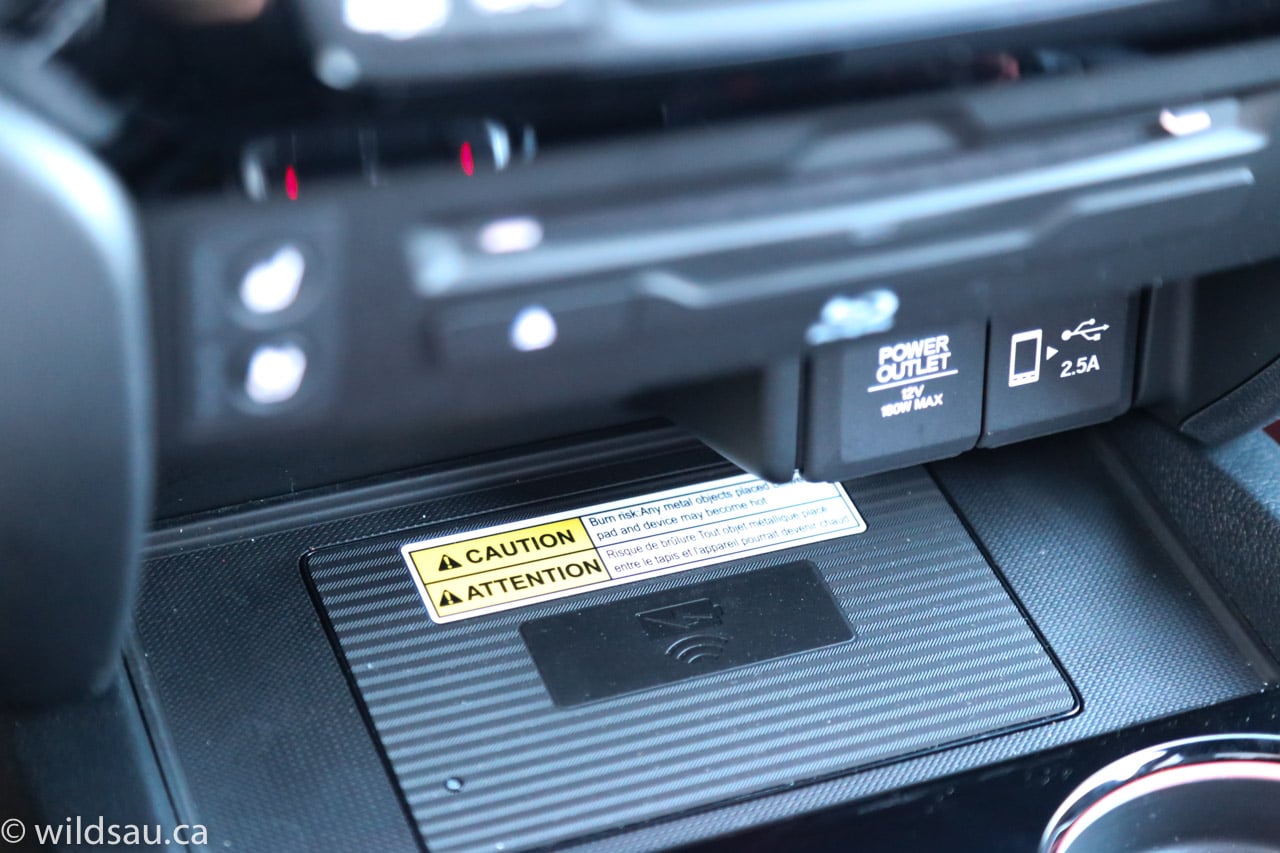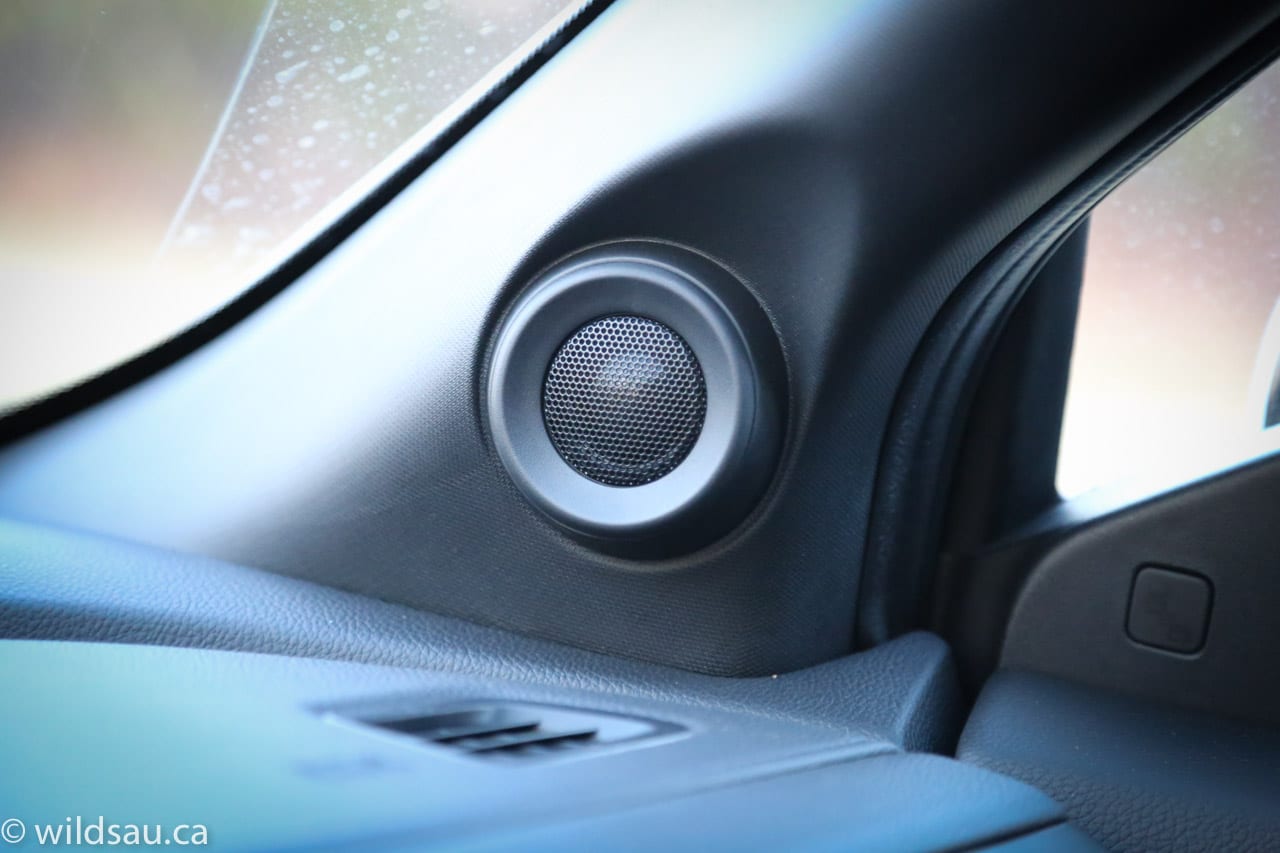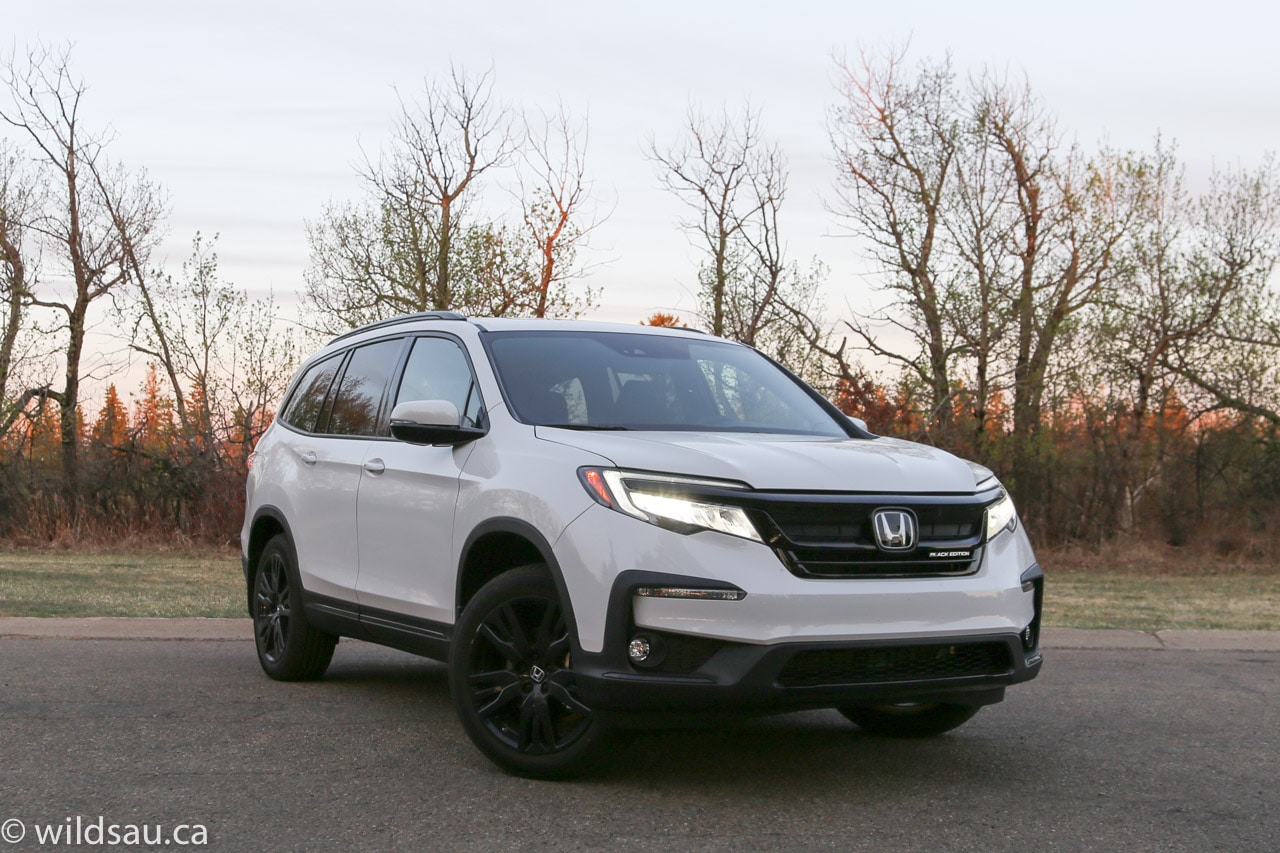The fancy-shmancy Black Edition of Honda’s Pilot.
Review and photos by Tom Sedens
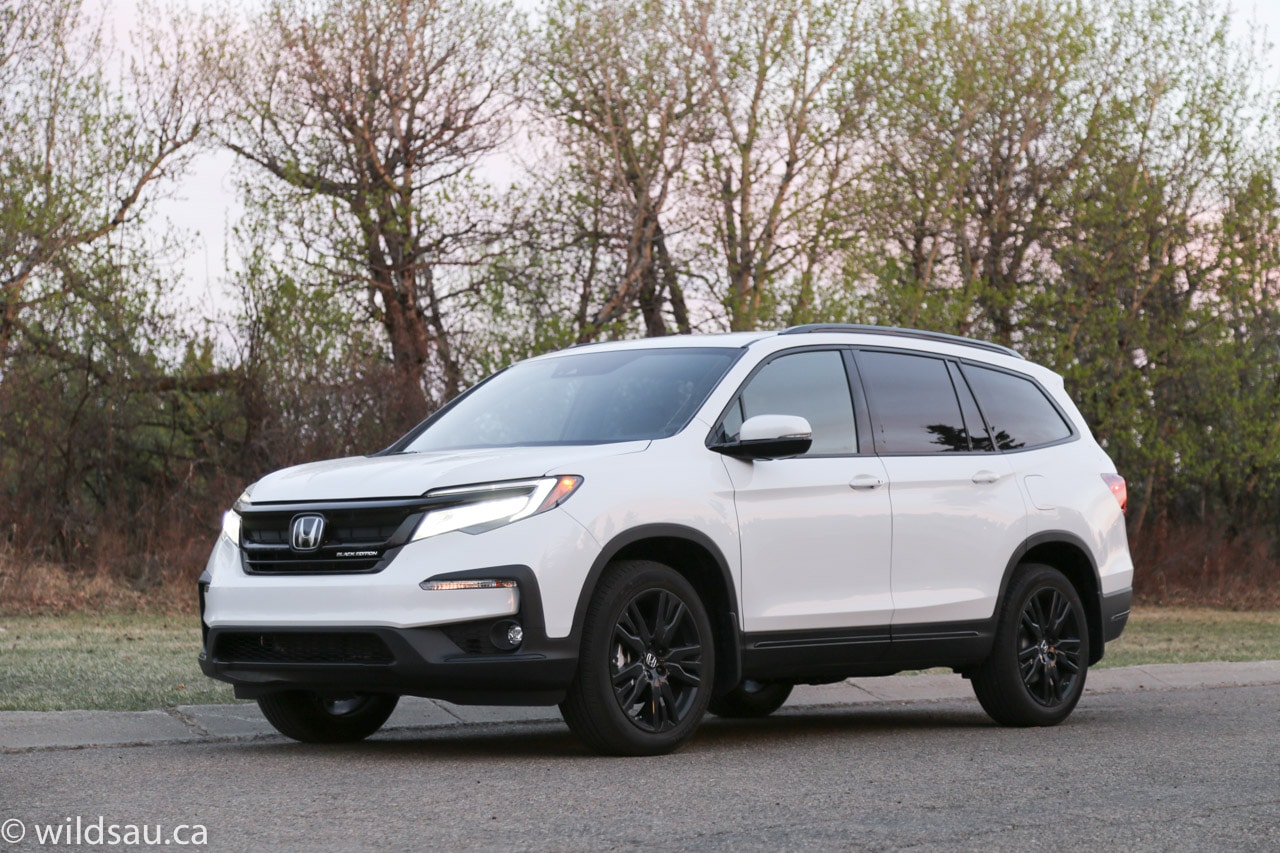
Pricing: 2021 Honda Pilot
Base price (Black Edition trim): $56,805
Options: none
Freight: $1,870
A/C tax: $100
Price as tested: $58,775
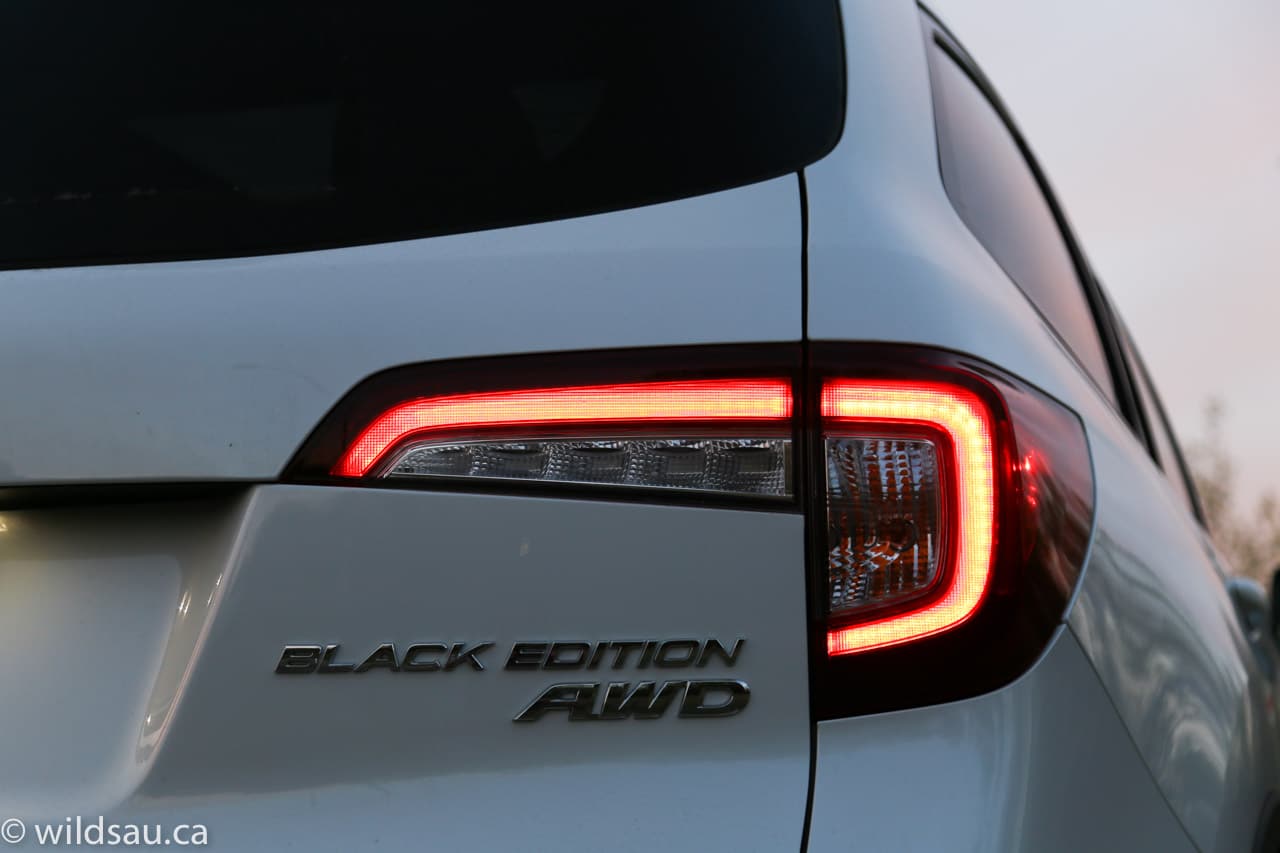
This is Honda’s top-of-the-heap trim for their biggest SUV/crossover, the Pilot. While the Pilot at base starts a hair less than Honda’s smaller two-row Passport, this top-line trim takes things as high as they can go in terms of luxury, tech and comfort and it is only available in the 7-passenger configuration – other Pilot trims are available as 8-seaters too.
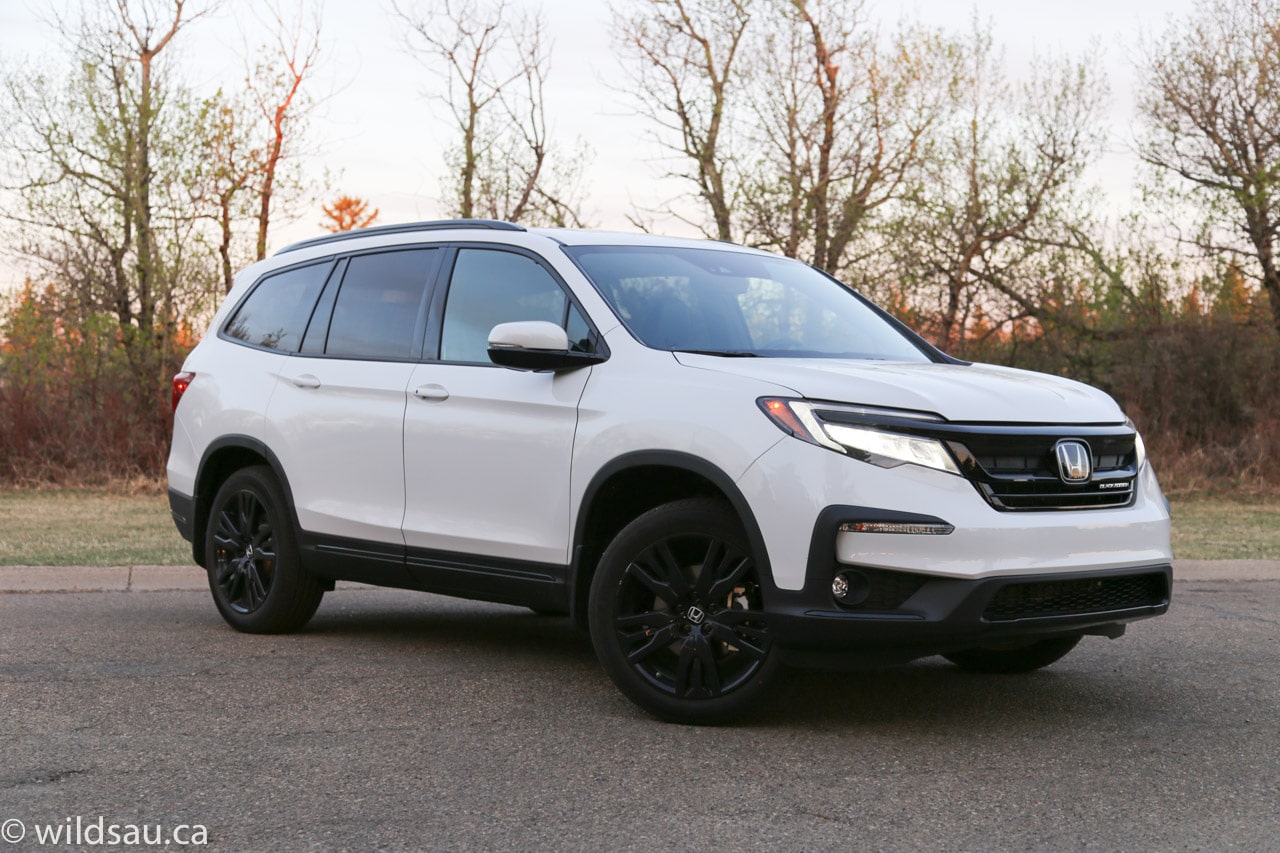
Exterior
For a big SUV, the Pilot has some nice clean sleek lines. I like the muscular sculpting on the hood and overall, even though it’s looked like this for a while now, it remains a handsome modern-looking ride.

The Black Edition is purely an aesthetics package – it reduces your paint choices to white or black. My review sample came in Platinum White Pearl, and it is here that the trim’s black accents are most visible. You get blacked-out trim on the bumper’s skid plate, the grille, the mirrors and even the roof bars.
You’ll get LED lighting all the way around – headlights, foglights and tail lights.
The Black Edition’s wheels are trim-specific black 20-inchers, wearing big 245-50-sized tires.

Interior/Tech/Convenience
The Pilot’s cabin is spacious and offers excellent headroom.
The Black Edition adds special stitching to the seats and floor mats, and you get red ambient lighting, versus the blue in other Pilot trims.
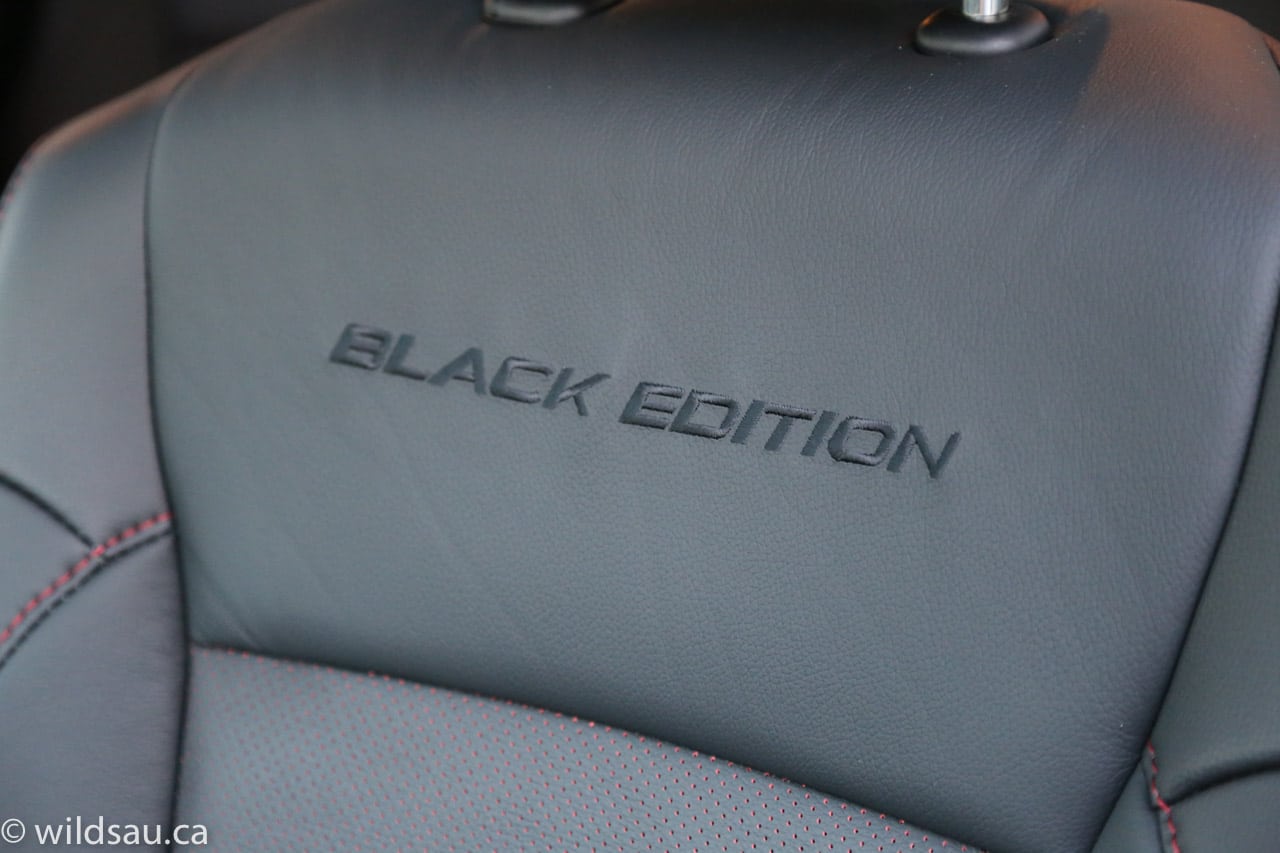
The materials in the Pilot’s cabin are mid-range. There are plenty of soft-touch surfaces, but with an interior this big, you’ll also find oceans of hard plastics. The gloss black panels on the dash and console are fingerprint and dust magnets. With a few minor exceptions, everything is black so it’s all business in there and it gets a tad sombre for my tastes after a while.
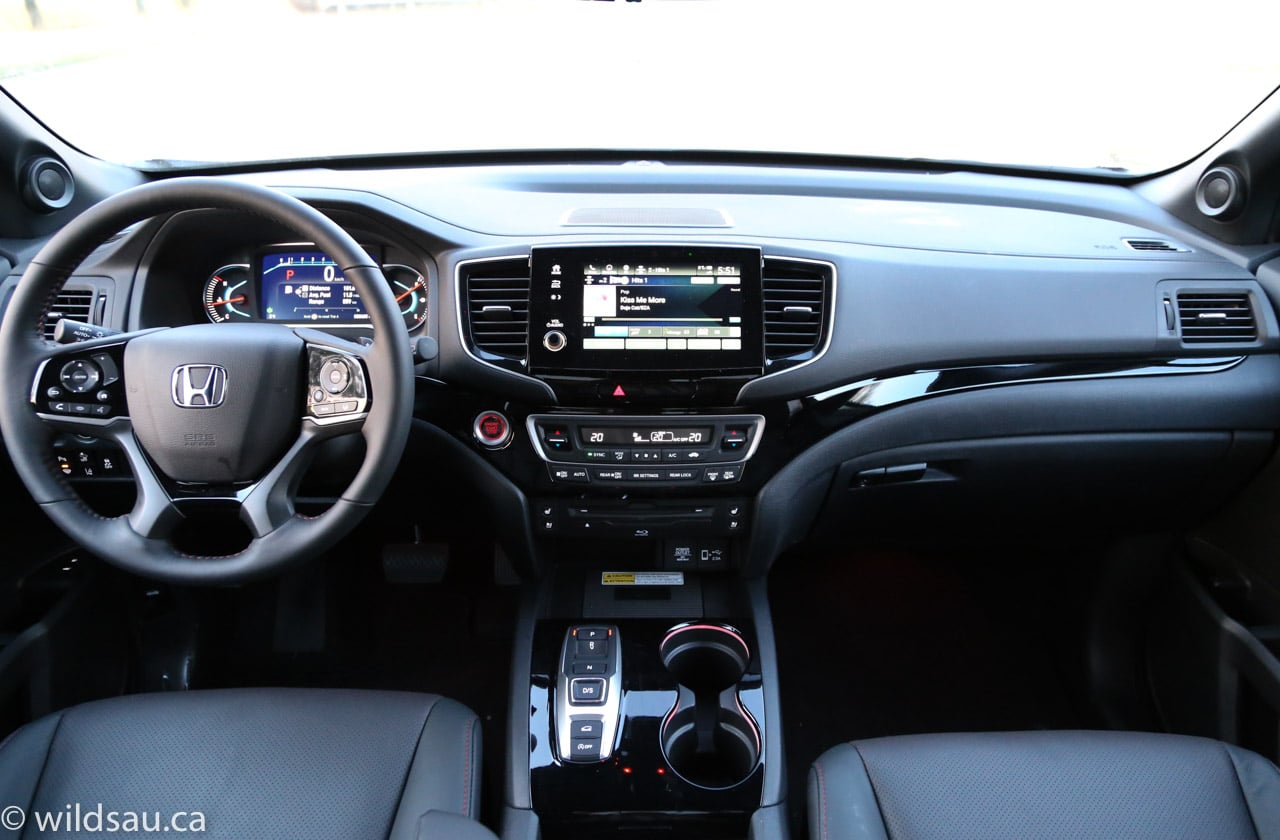
The heated steering wheel sits in front of a big 7-inch digital driver information screen which is flanked by a couple of analog gauges for fuel and temperature.
The front seats – heated, ventilated, power-adjustable and upholstered in lovely perforated leather – are very comfortable and reasonably well bolstered for an SUV – we really liked the adjustable armrests too.
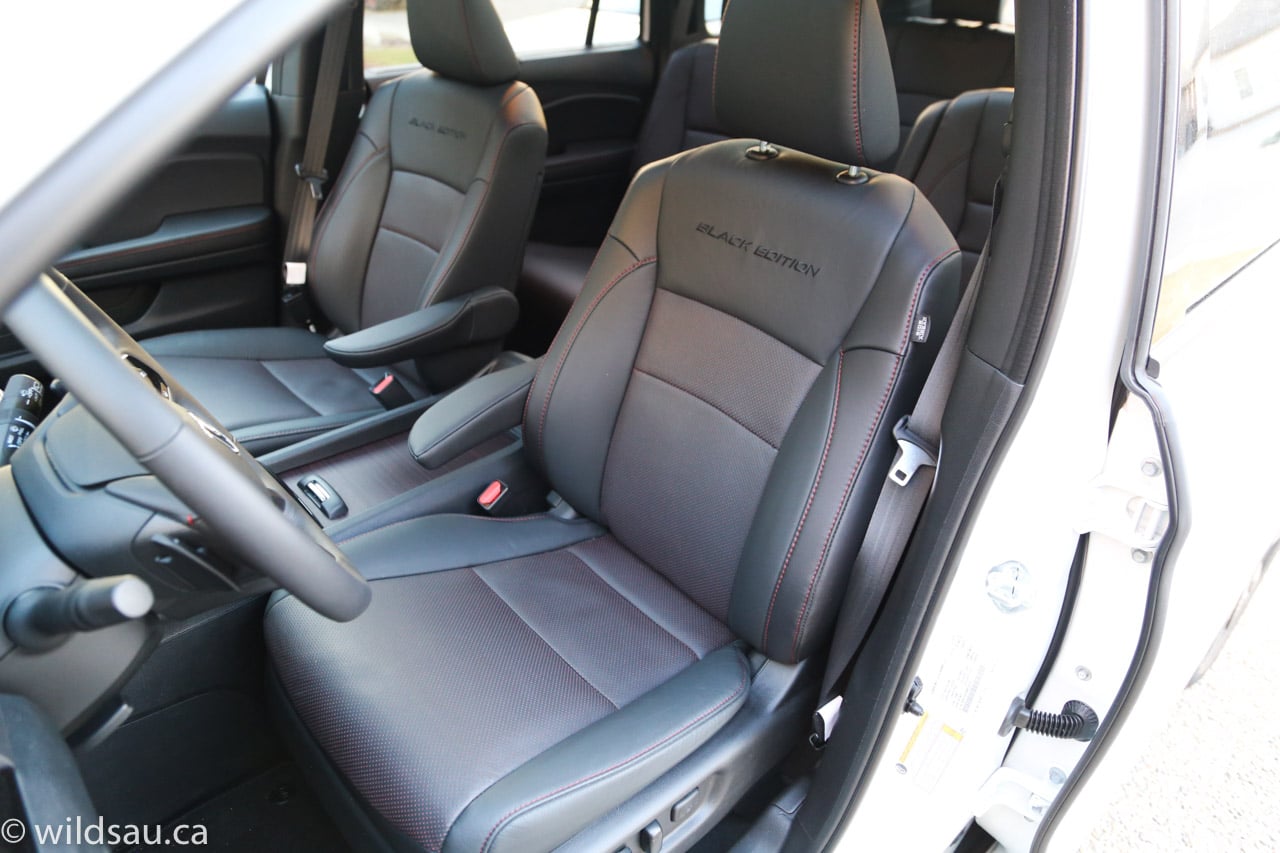
The 8-inch touchscreen handles everything from phone, navigation, vehicle settings to the 600-watt 11-speaker sound system – which is great. It works well with Apple CarPlay and Android Auto. I’d appreciate the addition of some hard buttons for the main functions, but Honda did include a volume knob and that’s better than nothing. While the screen isn’t large by today’s standards, many will appreciate the fact that it’s contained in the dash and doesn’t jut up out of the dash like most of them do.
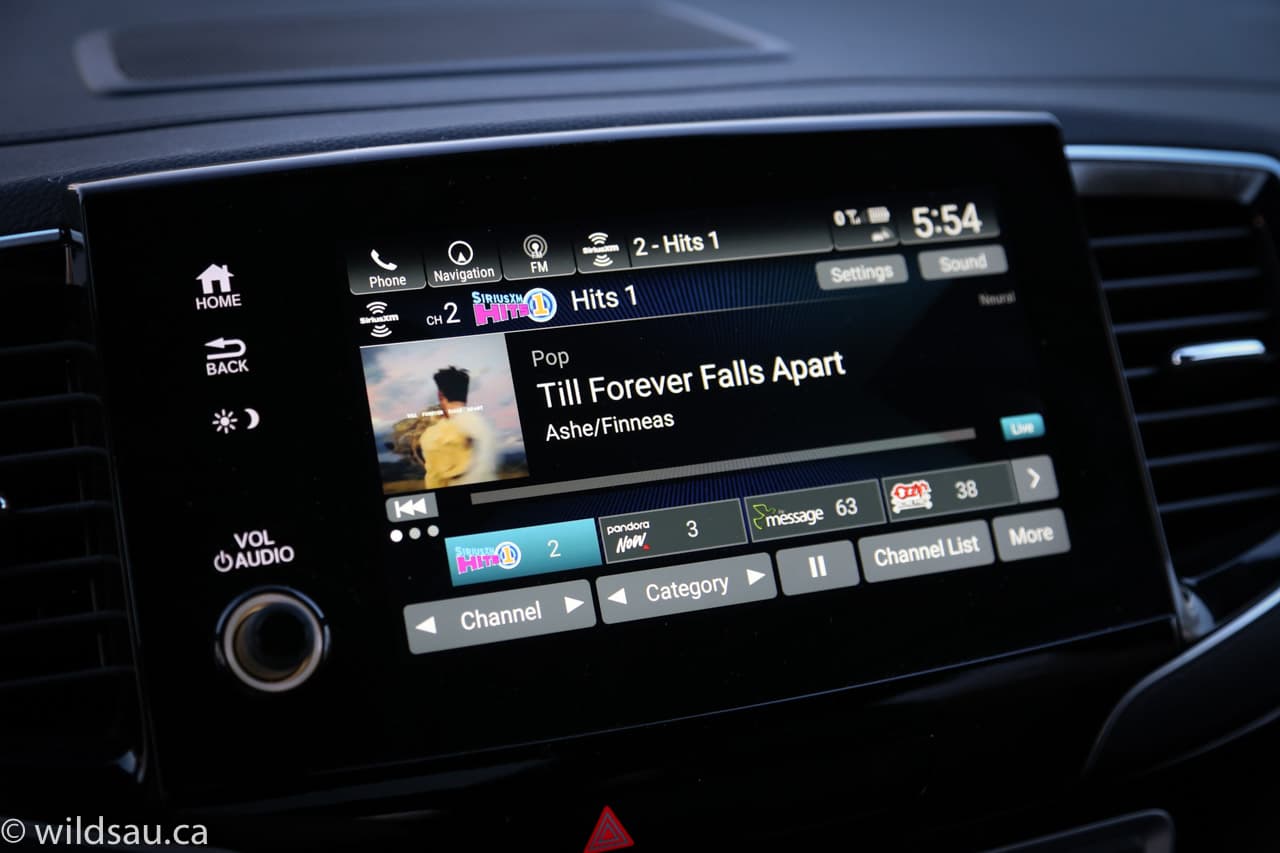
Below the screen is the automatic tri-zone climate control system. Wireless charging is found at the front of the console – above it are USB-A and 12V charging ports.
There’s a fantastic dual-pane sunroof overhead – a standard-sized one over the front seats and a huge one over the second and third row.
There’s a wealth of driver assistance technology in this top trim. You get a multi-view back-up camera, forward collision warning and collision mitigation system, lane departure warning and lane keep system, road departure mitigation, adaptive cruise control, rear cross traffic monitoring and blind-spot monitoring. Honda’s forward collision warning system in other vehicles can be hyper-sensitive and that makes it very conservative and super-annoying, but everything worked really well during our time in the Pilot.
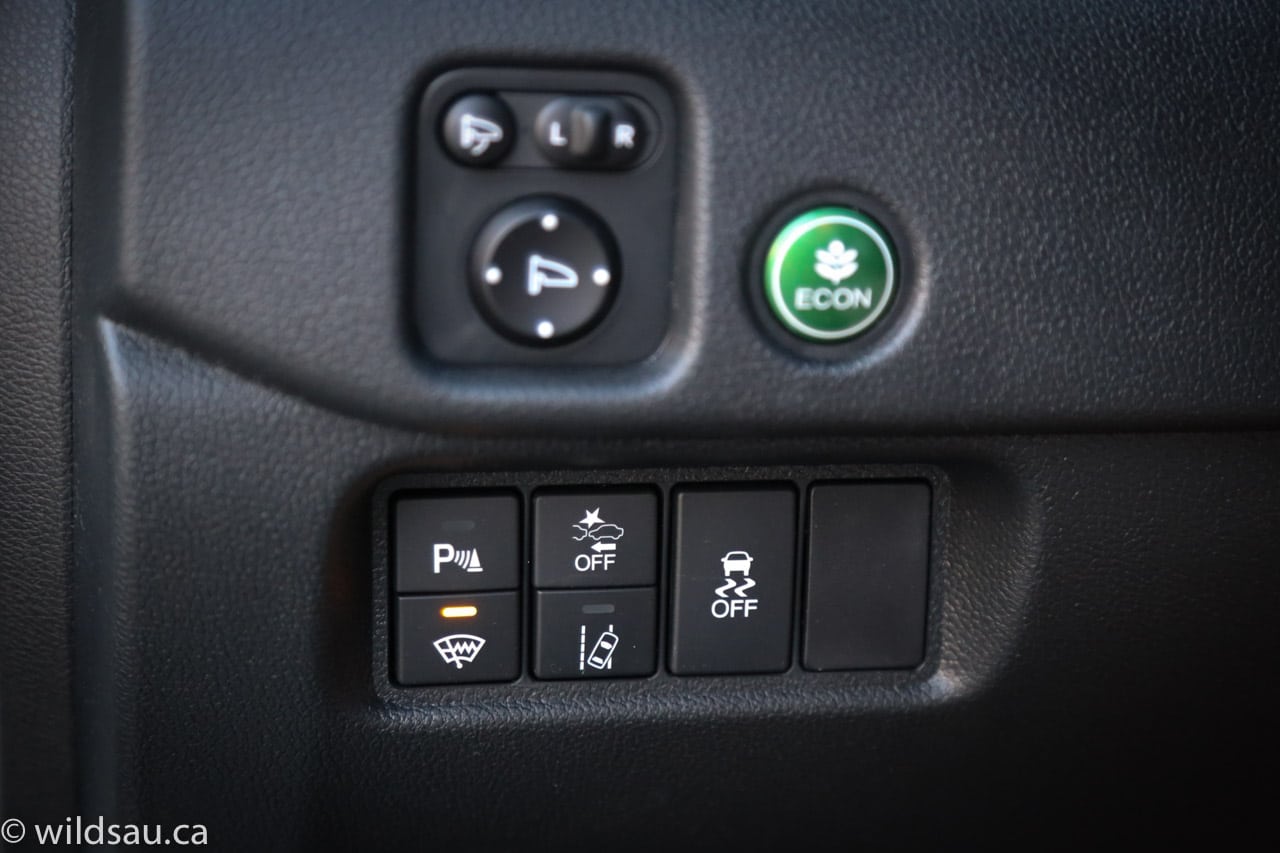
Second and Third-Row Seats
The heated second-row captains chair seats were very comfortable and fully adjustable, reclining and sliding fore and aft.
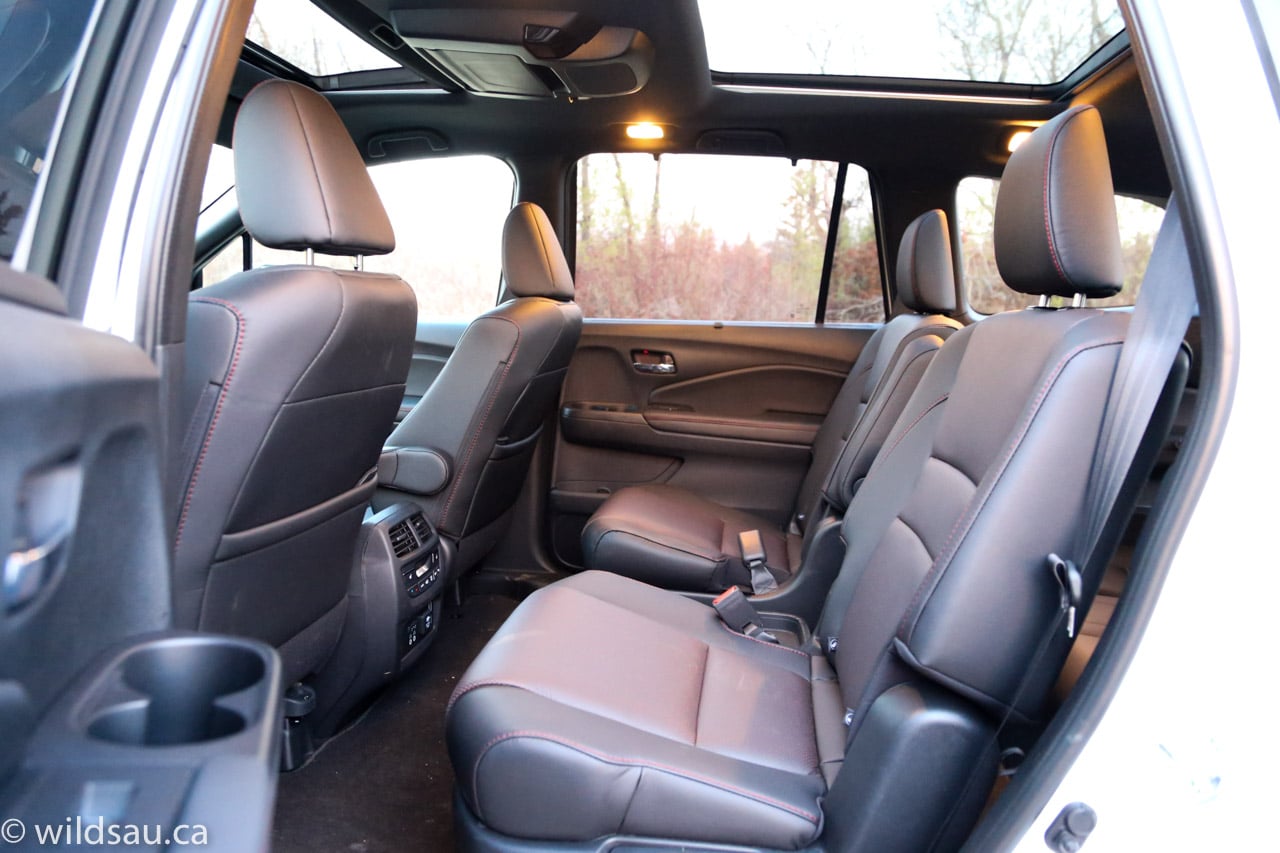
Second row passengers get a bunch of fun stuff for their comfort and convenience. A full set of automatic climate controls for a separate climate zone, a couple of USB-A plugs and a 115V household plug, a lower centre console with cupholders and a rubberized tray and additional cupholders in the doors. There are also adjustable air vents and manual sunshades for the side windows.
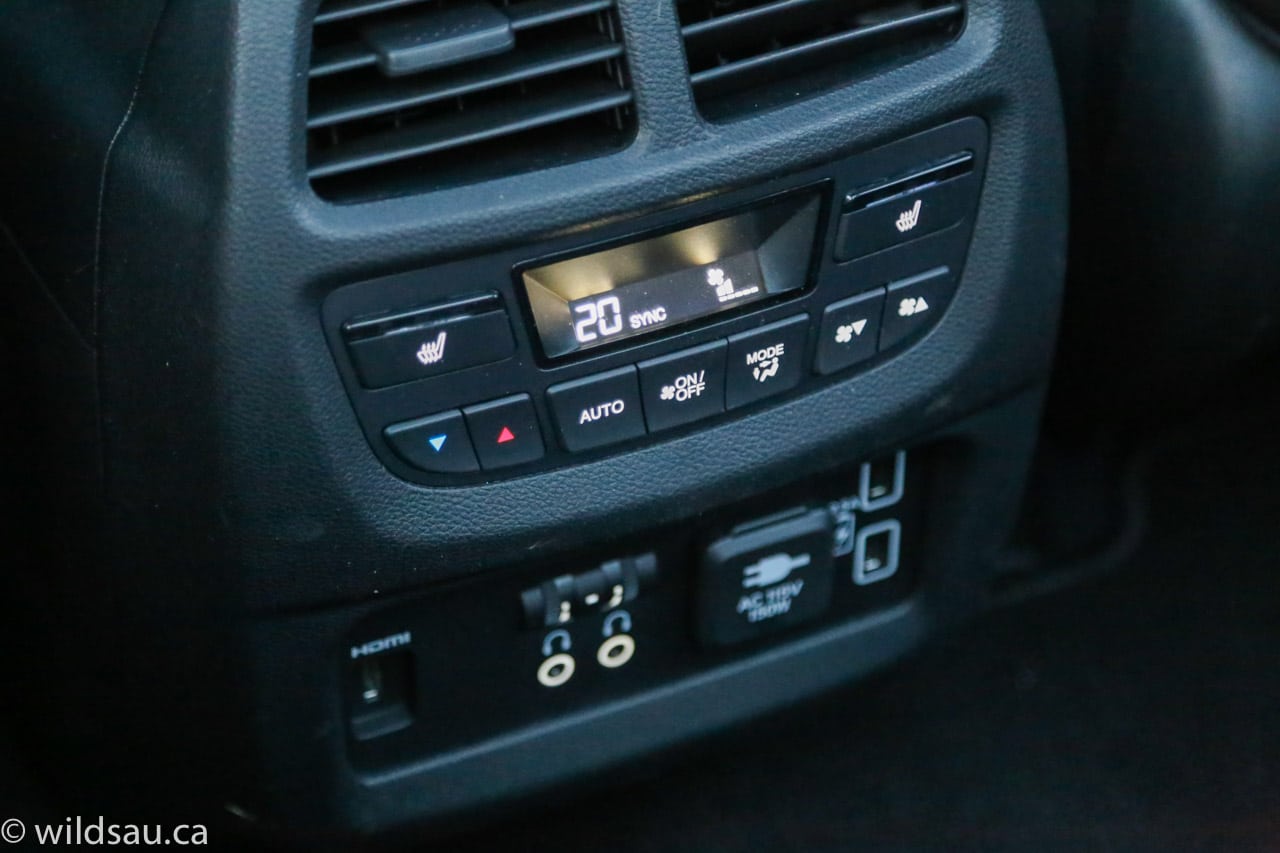
When it comes to getting those captains chairs out of the way to access the third row, Honda’s excellent one-touch tilt and slide buttons can be found on the backs of the seats and on the outside of them, so you can move them from outside or from the third row to get out.
The third row isn’t a joy to get into if you’re an adult. Once you’re in, you won’t find a roomy space – none of them are in this category – but it’s actually not bad for the two outboard seats – the middle one is for emergencies, infants or doggos. I’m 5’10” and I had enough headroom and legroom. The seats are very close to the ground so an adult won’t find it particularly comfortable, but it’s not the emergency-use-only space some competitors’ third rows offer either. I’d call it a reasonable compromise, space-wise.
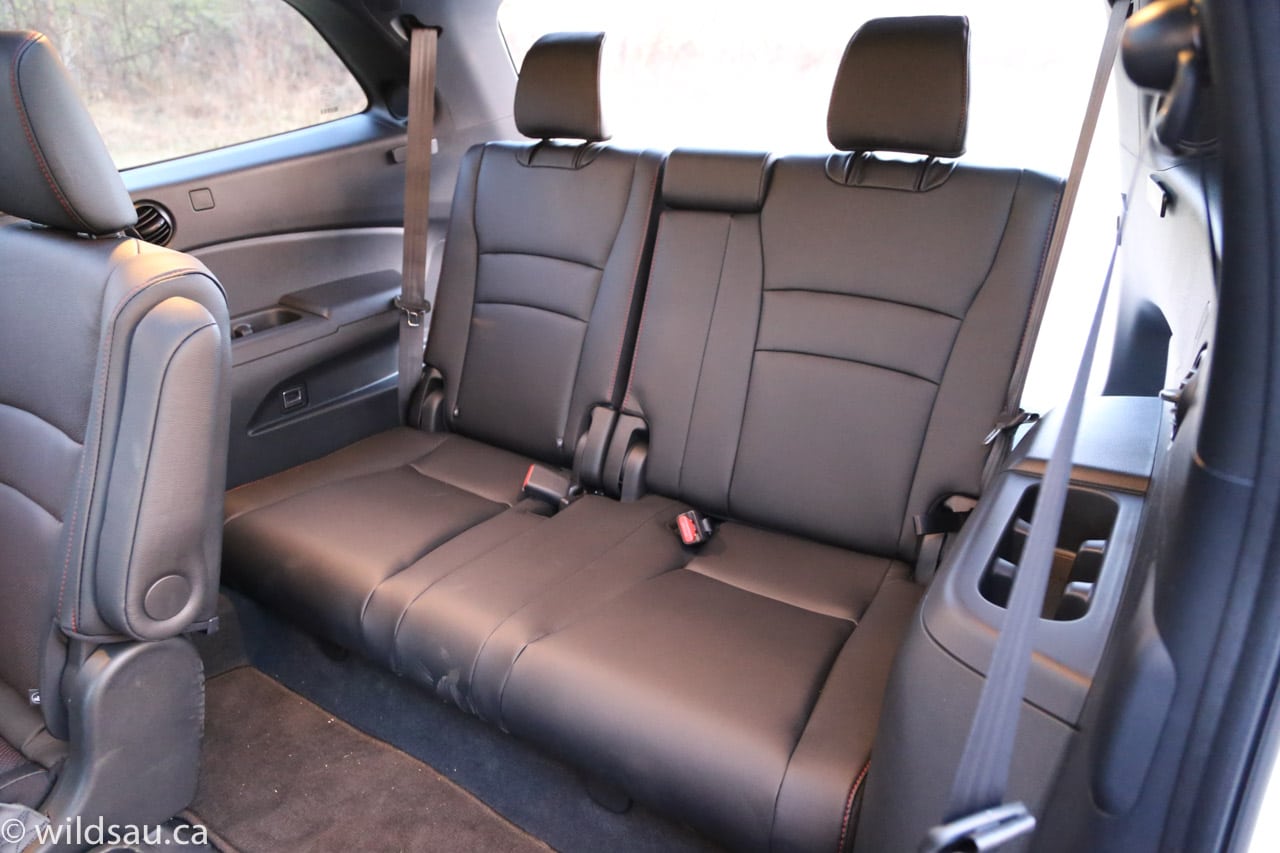
Third row passengers get adjustable air vents and bin-cupholder combinations on the sides, and that’s about it.
It feels a bit old-school but both back rows can look up to watch stuff on the central drop-down entertainment system – it’s a sharp 10.2-inch screen and can be fed from a variety of sources. There’s a built-in BluRay player, embedded media streaming app, as well as USB and HDMI hardware connections and two headphone plugs. Apps include the “How much farther?” winner for the kids. The system includes a pair of wireless headphones and a remote.
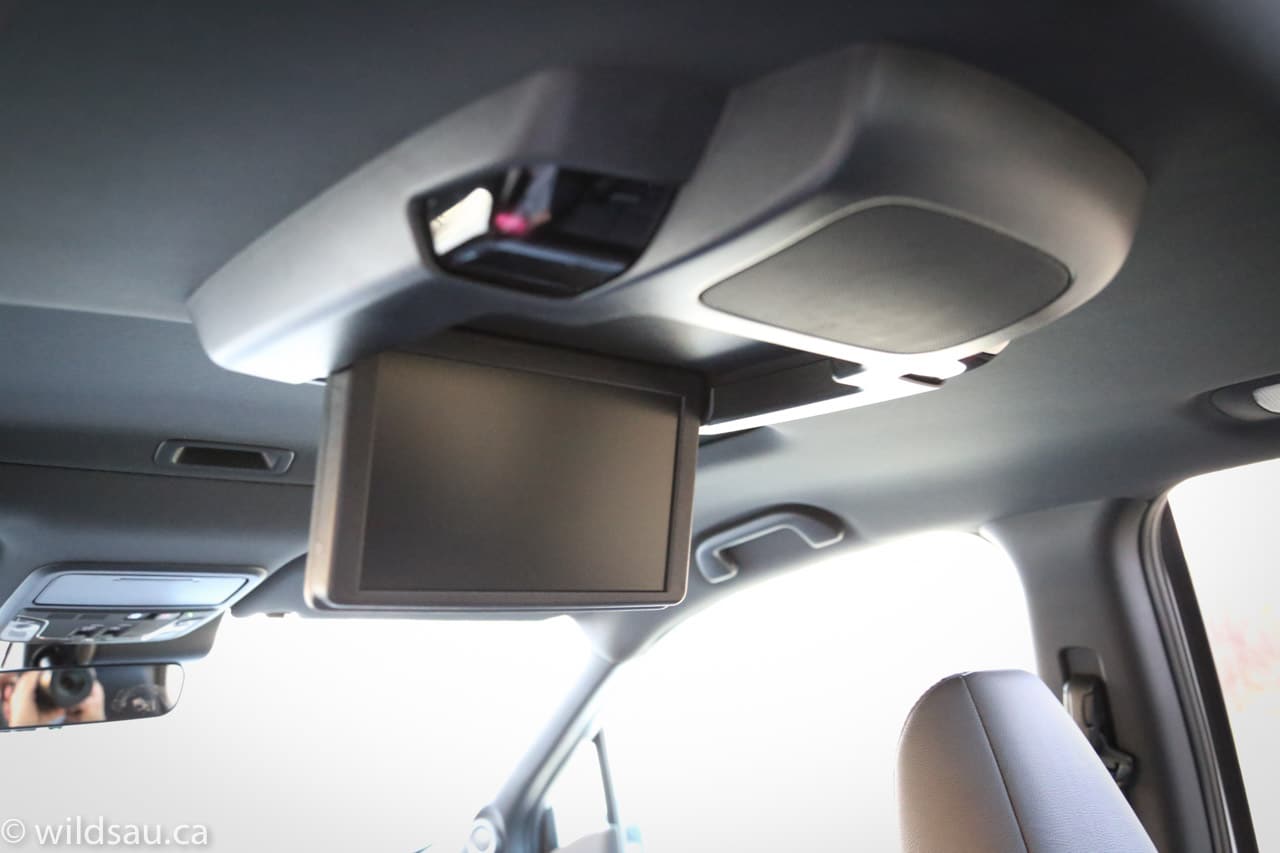
For the record, I asked our three kids (aged 17, 13 and 10) if this system appealed to them and none of them were even remotely interested. Were we to head on a road trip, they would be bringing their own devices.
Storage
The centre console houses a huge bin under a scrolling lid – it has a movable organizer tray as well as auxiliary, USB and 12V plugs.
Pop the power tailgate (it works hands-free too) and you’ll find surprisingly useful space to the tune of 510L behind the third row – there’s also a 12V plug for accessories.
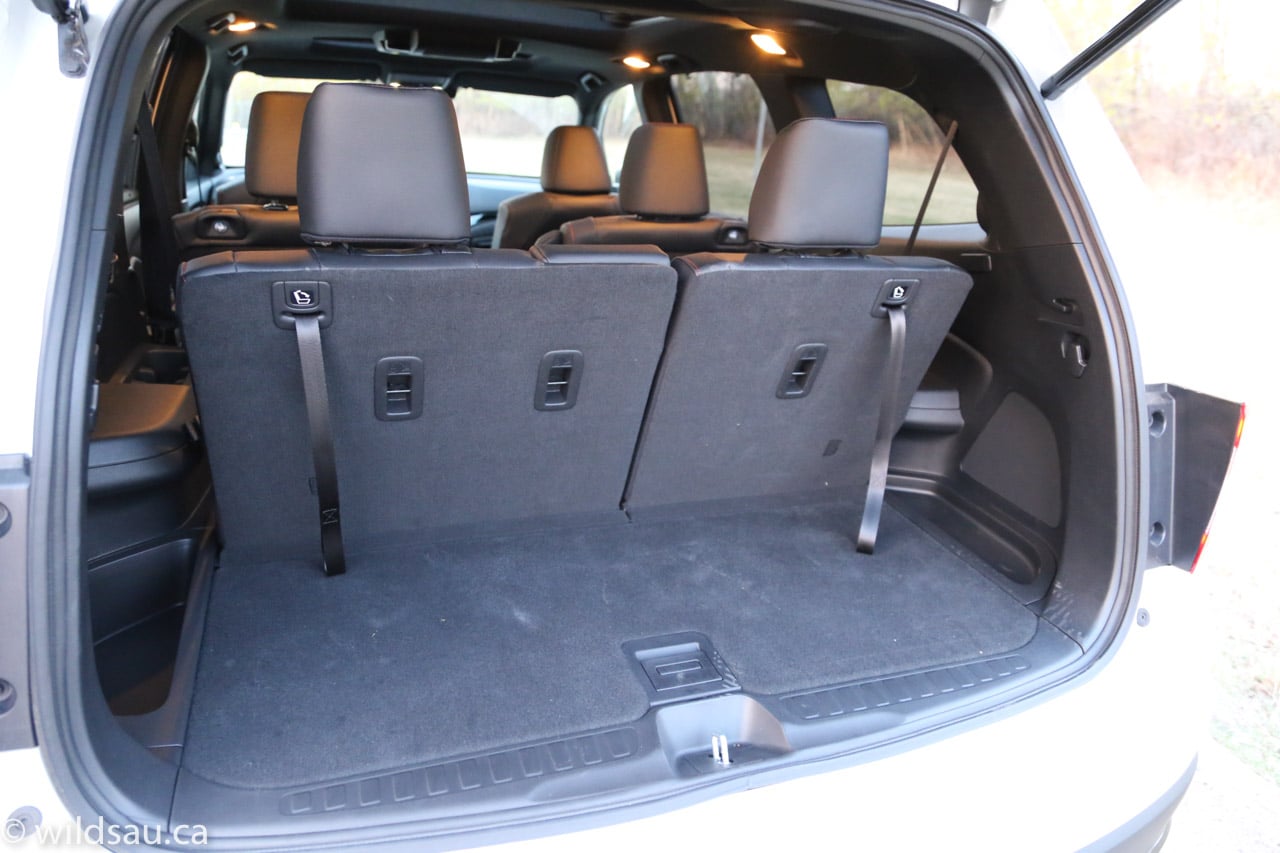
Fold the third row down (it splits 60/40 and requires manual pull straps) and you get a solid 1583L trunk. There’s a huge underfloor storage bin and organizer trays on either side of the trunk. If you need more, the second row seats can fold down too, leaving a cavernous 3072L cargo space.
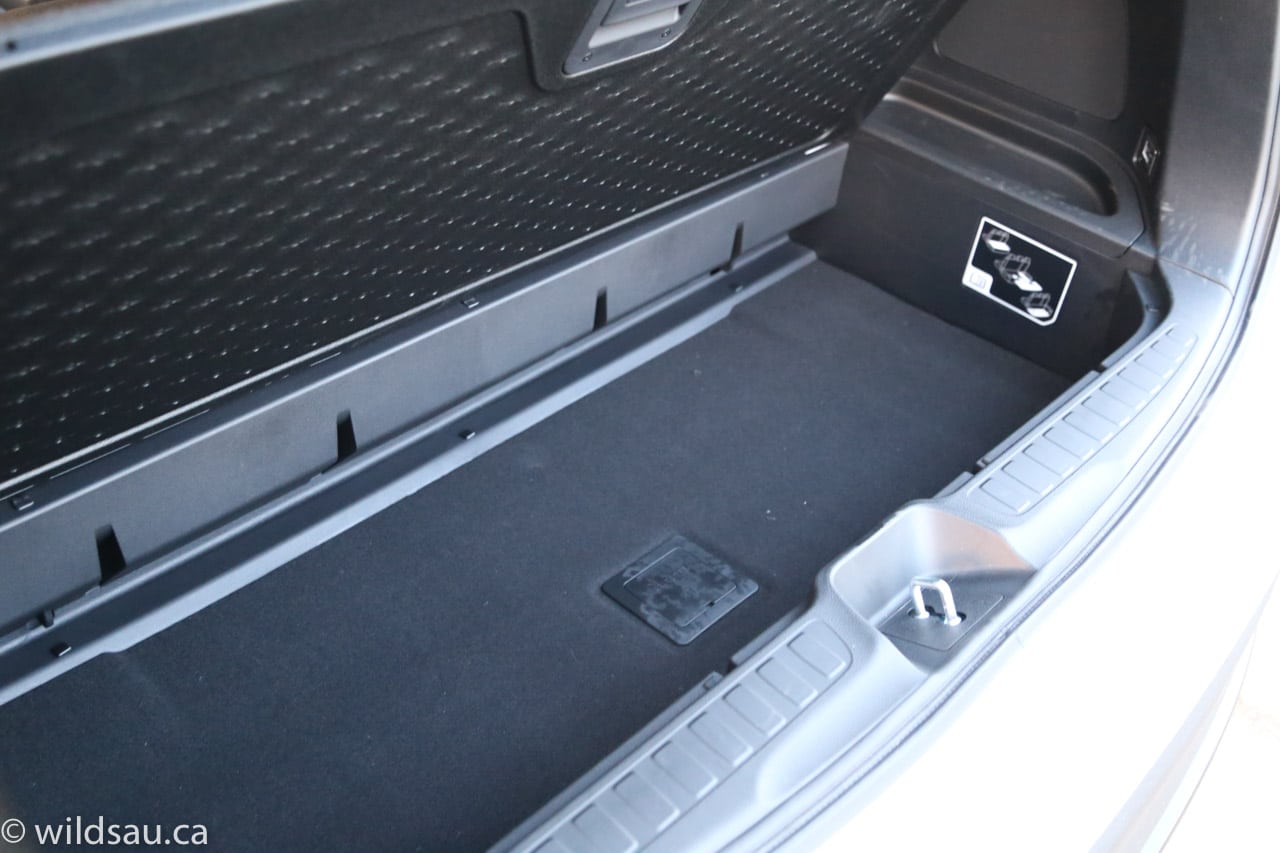
Under the Hood
The motivation for this SUV comes from Honda’s tried and true 3.5L V6 – it puts out 280 HP at a soaring 6,000 RPM and 262 lb.ft of torque at 4,700 RPM.
The engine is mated to a 9-speed automatic and an all-wheel drive system. The vehicle is rated at 12.4/9.3/11 L/100 km (city/highway/combined). We ended up spending most of our time in the Pilot doing suburban commuting with an average of 12.1 L/100 km.
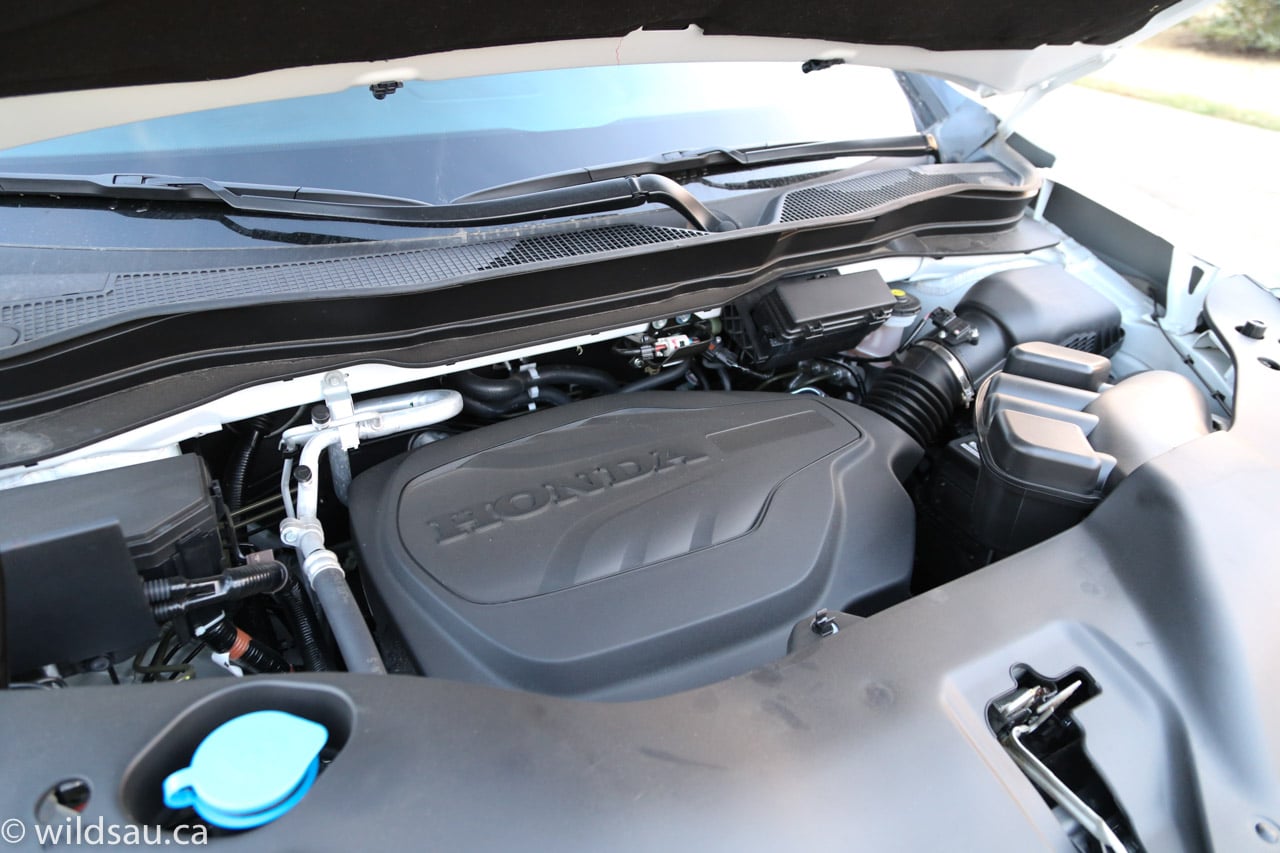
The Drive
The powertrain provides good pick-up off the line. Once you’re on the move, it’s not slow by any means, but it feels like the engine has to work hard to move things along – and it sounds like it too. Although it makes some coarser sounds when you’re heavy on the gas, it almost always feels smooth.
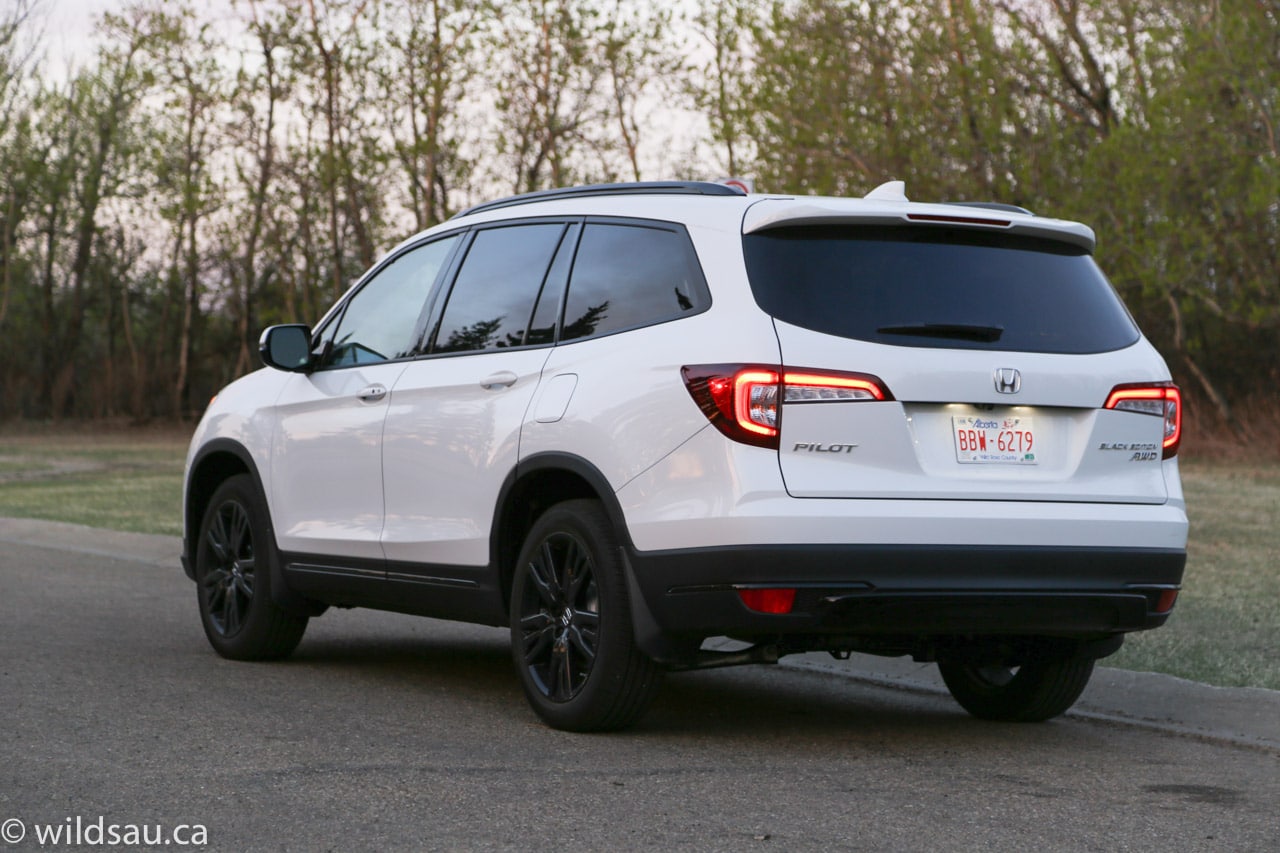
The smooth-shifting and intelligently programmed transmission was excellent. It felt like it was almost always in the right gear at the right time. Gears can be shifted manually using the paddle shifters, and there is a Sport driving mode as well. I’m still not a big fan of the push-button gear selectors, and this one is no exception.

The Pilot has a traction management system allowing you to choose between a number of drive modes – Normal, Snow, Mud and Sand. And there’s an Eco mode as well.
The ride is firmer than I would have wanted in a big comfortable SUV. It’s not rough, but definitely taut – and noisy. I found a lot of road imperfections drummed through to the interior. The handling is fine – it’s not a sports car, but it holds its own and competently grips the tarmac in all driving situations.

Brakes are powerful but not too grabby and the visibility out of the vehicle is decent, especially the driver’s view of the road ahead.
If you’re towing, the Pilot (when equipped properly with the optional dealer-installed towing package) can haul up to 5,000 pounds (2,268 kg) around.
Details
There’s a nifty novelty intercom system allowing you to speak to rear passengers from the front – Honda calls it the CabinTalk PA.
Honda is adding remote starters to most of their vehicles now, including the Pilot, and that’s a great thing.
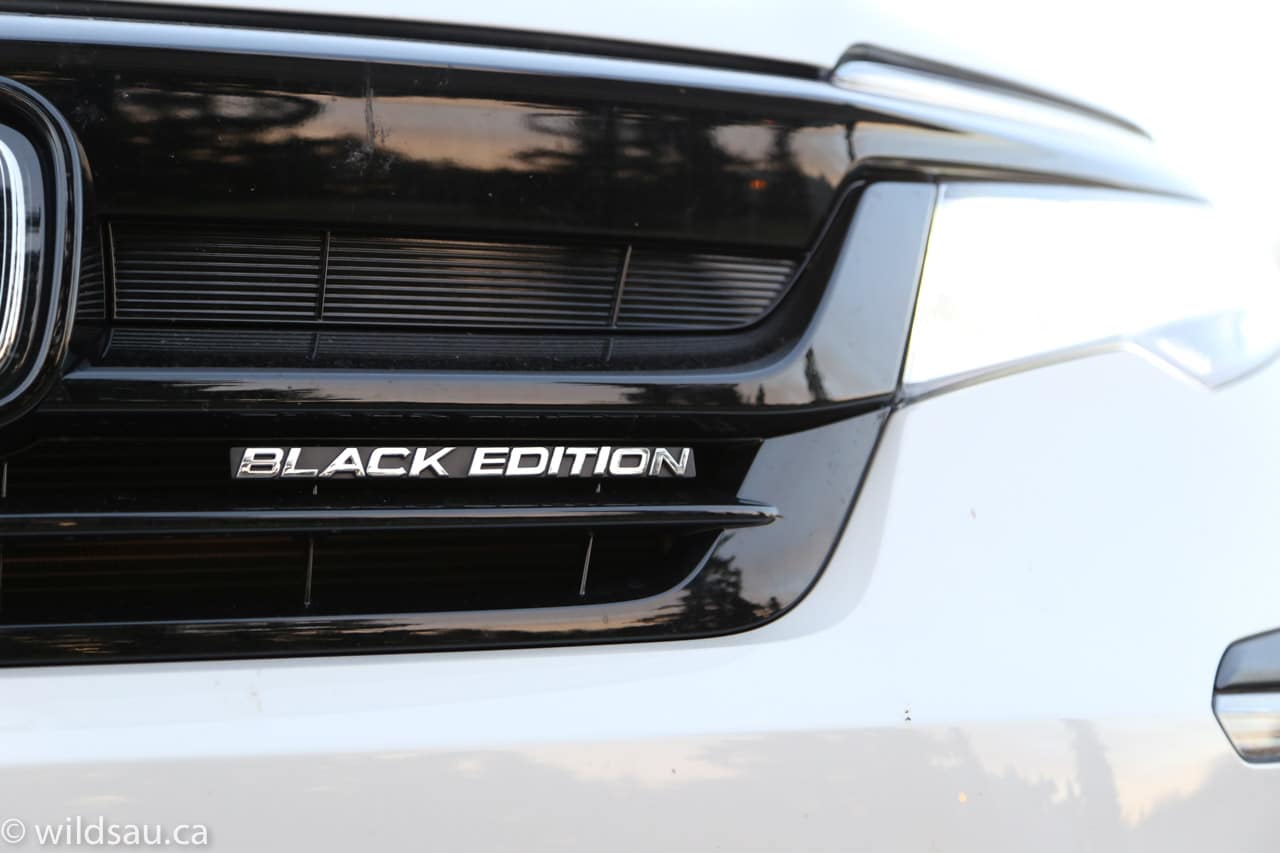
I love thoughtful little touches – Honda’s additional little “sleeve” inside the rear map pockets is the perfect place for rear passengers to store their phones.
Nitpicks
While the pull-strap mechanism to fold the third-row seats down works fine, it becomes a big pain and a huge reach into the trunk to get them back up. It would be nice to see a powered folding option for that reason.
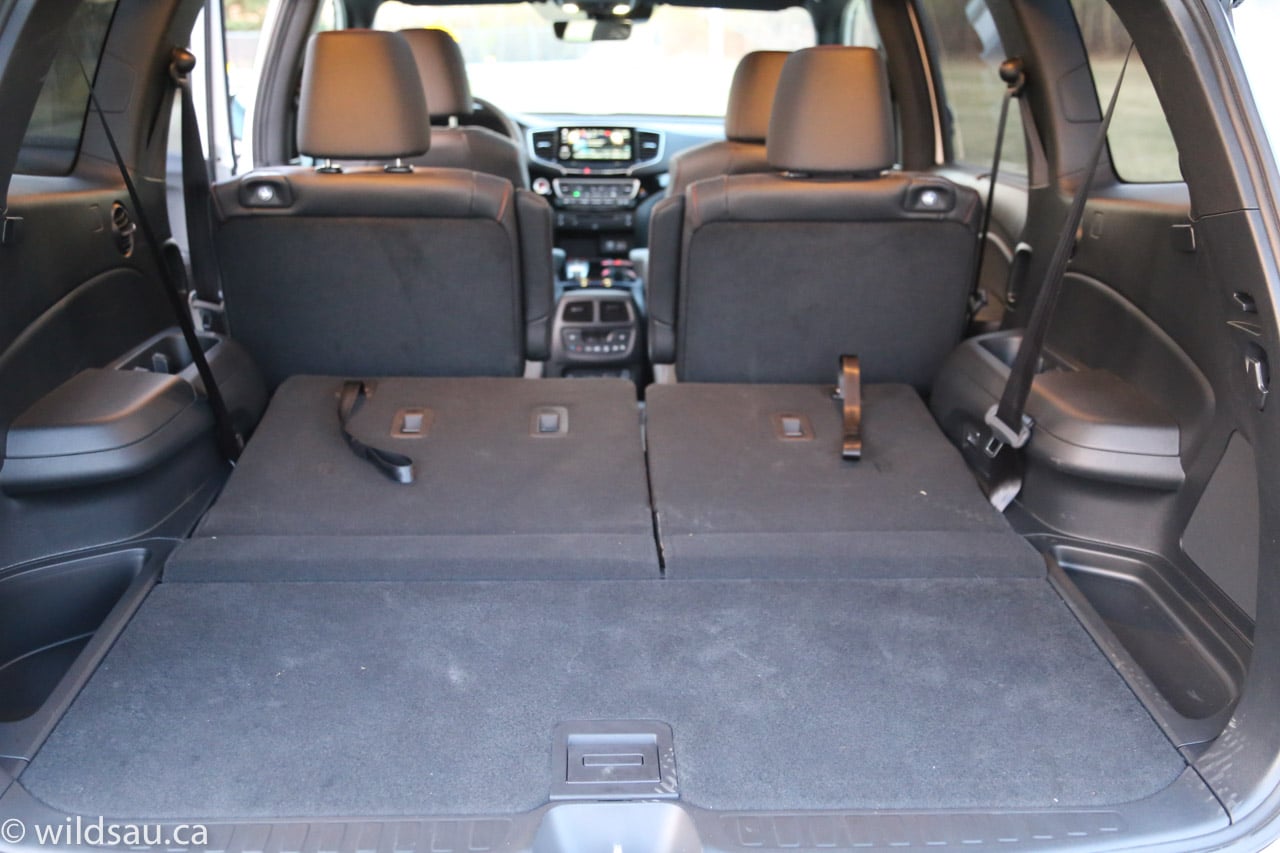
The Verdict
WAF (Wife Approval Factor) was middling. She didn’t have any real nitpicks but she wasn’t thrilled with it either.

The Pilot, while seeing refinements, improvements and refreshes along the way, has been with us in its current guise for a while. It’s still a great SUV in many ways, although it doesn’t feel as current as some of the competition. It isn’t going to turn many heads but it still looks good and it certainly has an adequate powertrain. It offers up plenty of comfort, massive and flexible cargo space and utility and is generally as luxurious as any of the other players in this class.
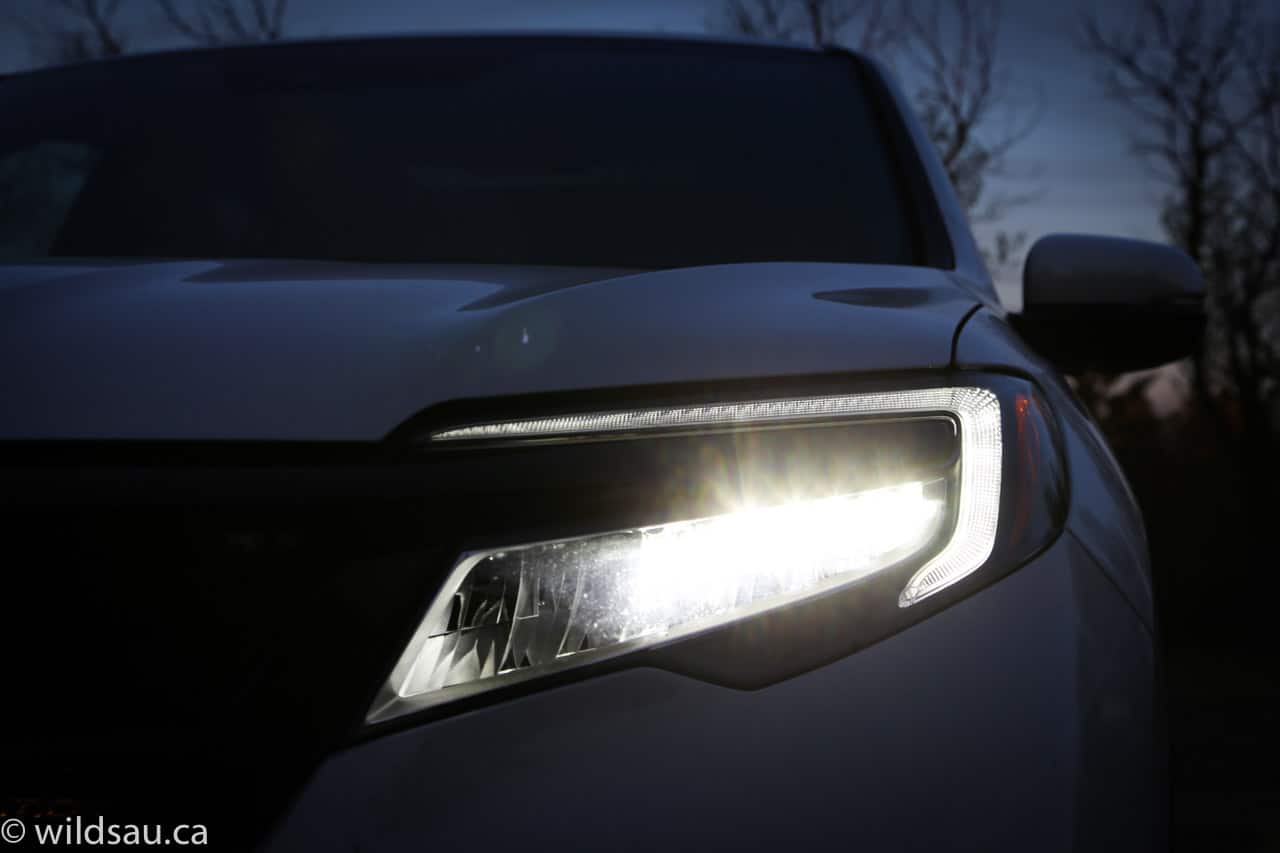
The Black Edition has some nice touches, but honestly it doesn’t quite bring the same menacing attitude in the white as it does when it’s paired with the black paint. I’d either choose it with black paint, or forego this trim for the Touring which is very comparable and would save me a few bucks.

Disclosure: Vehicle was provided by Honda Canada.
If you enjoyed this review, feel free to check out my other vehicle reviews under the car reviews tab at the top of my blog.
